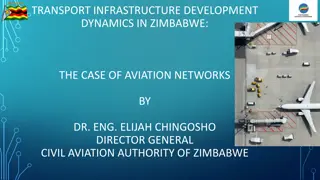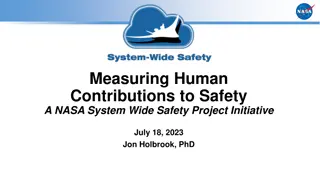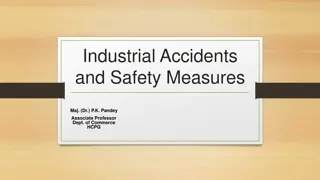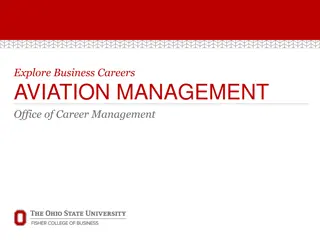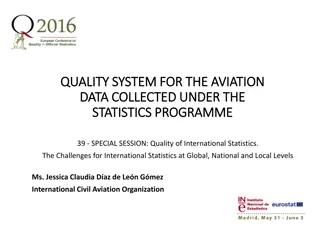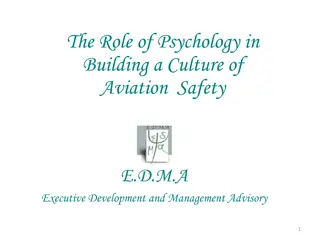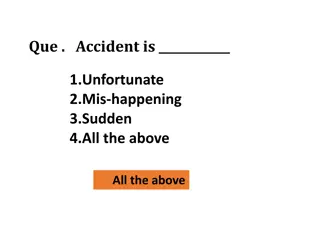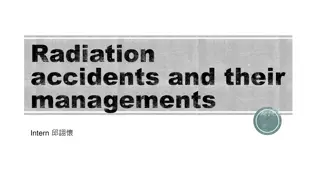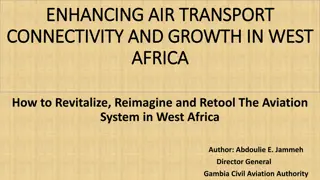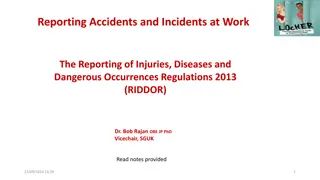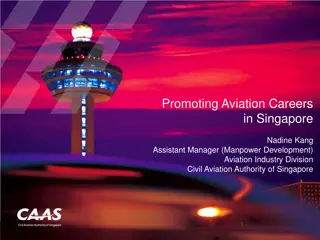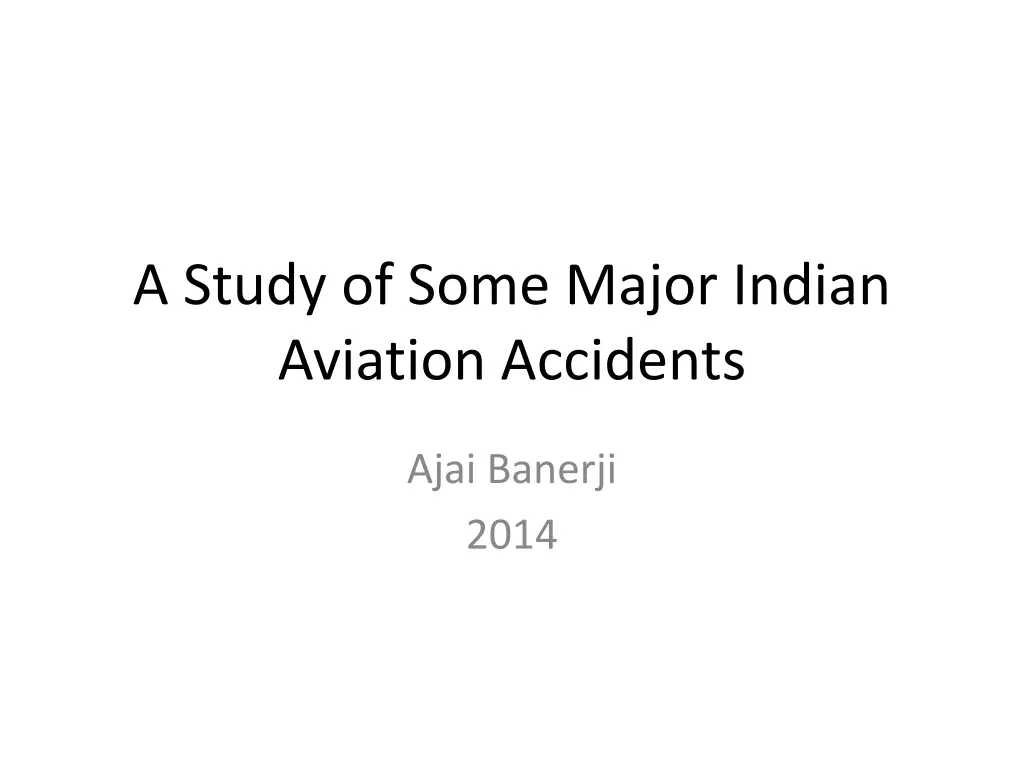
Indian Aviation Accident Analysis
Explore a study of major Indian aviation accidents, highlighting causes and aftermaths. Learn about the 1978 crash off Bombay due to the malfunction of the Attitude Direction Indicator and the consequences of the crew's actions.
Download Presentation

Please find below an Image/Link to download the presentation.
The content on the website is provided AS IS for your information and personal use only. It may not be sold, licensed, or shared on other websites without obtaining consent from the author. If you encounter any issues during the download, it is possible that the publisher has removed the file from their server.
You are allowed to download the files provided on this website for personal or commercial use, subject to the condition that they are used lawfully. All files are the property of their respective owners.
The content on the website is provided AS IS for your information and personal use only. It may not be sold, licensed, or shared on other websites without obtaining consent from the author.
E N D
Presentation Transcript
A Study of Some Major Indian Aviation Accidents Ajai Banerji 2014
Aviation safety in perspective Aviation disasters make big headlines- particularly with unusual incidents like MH 370 and MH 17. But improved technology has reduced accident rates considerably all over the world. India provides a good example-there was no fatal crash of an Indian commercial airliner between June 2000 and May 2010.
Some major Indian aviation disasters we will look at Air India Boeing 747 off Bombay on 1 Jan 1978: 213 dead Air India Boeing 747 in the Atlantic Ocean on 23 Jun 1985: 329 dead Collision of Saudia Boeing 747 and Kazakhstan Airlines Il-76 over Haryana on 12 Nov 1996: 349 dead Air India Express Boeing 737 at Mangalore on May 10, 2010: 159 killed, 7 survived.
Presentation We first look at a summary of the facts of the accidents (including the inquiries by aviation authorities as well as judicial inquiries in each case). We then discuss the primary causes of the accident and peculiar circumstances involved.
Points to note The primary cause was the malfunctioning of the Attitude Direction Indicator
Why the crew faltered The cockpit crew had 3 members-pilot, co- pilot and flight engineer. There were three separate sets of instruments. Only the pilots ADI malfunctioned, falsely showing a right bank so he corrected it by banking to the left. The other two ADIs were apparently working but the other crew did not take action to correct the pilot.
Why it crashed Due to the faulty left bank by the pilot, the plane spun out of control from about 2000 ft. Recovery was not possible at this height and it crashed into the sea.
Aftermath Legal action was taken against Boeing and the instrument manufacturers in an US court. After several years they were found to be not responsible for the crash. The court took the view that the cockpit crew had acted wrongly.
Main points Conspiracy hatched by militants in B.C. province of Canada Not enough surveillance on them by Canadian police and intelligence The plan was to blow up two Air India planes. The second attempt failed as the bomb exploded at Tokyo airport on its way to the Air India plane But valuable forensic clues were obtained from there.
Mistakes which led to the disaster In both cases passengers checked in with their check-in baggage and then disappeared. This was not noticed by the airline staff at Vancouver and Montreal At Montreal, X-ray and explosive sniffers were used to examine the baggage but the X-ray machine was not working properly, while the persons handling the sniffers were not trained sufficiently to raise an alarm.
Further points Examination of fragments of the Tokyo bomb led to detection of some of the culprits. Some were jailed in Canada, and others died under strange circumstances. Legal wrangling in Canada went on for over 20 years. One technical point was the discovery that the electronics bay on the 747 was prone to damage from a bomb in the forward baggage hold. This was corrected.
Inherent causes At that time Delhi Airport had only primary radar- which gives distance and direction but not altitude. So the flight crew have the main responsibility of maintaining altitudes given by the controllers. The westbound corridor was too narrow and both incoming and outgoing aircraft had to use the same corridor-thus making mid-air collisions more likely. Both of these conditions were remedied after the crash.
Immediate causes of the accident The Saudia plane followed instructions on its westbound flight and was at its assigned height of 14,000 ft. The KA plane was heading eastward to Delhi and was asked to descend to 15,000 ft. Due to the general lack of English proficiency among the cockpit crew, they misunderstood and descended to 14,000 ft and met the other plane head-on. Neither aircraft was equipped with the airborne collision avoidance system, which was not mandatory at that time.
Conclusion The basic defects in Delhi s ATC were corrected with the installation of more advanced secondary radar as well as expansion of the corridors and creation of separate corridors for inbound and outbound flights. The general casual attitude of the Kazakh crew was noted as a factor in the accident.
Main points Mangalore is a table-top runway which needs particular care in landings and takeoffs. One rule is that the pilot and not the co-pilot is fully responsible for landings. However, the co-pilot did most of the preliminaries and then the pilot took over- after sleeping for most of the flight which was a clear violation of discipline.
Why it crashed The pilot was not fully alert and brought in the plane too high and touched the runway too far ahead of the specified area-which led to overshooting the runway and falling into a steep ravine. The co-pilot repeatedly warned the pilot that he was coming in too high and that they should circle and try again. But the pilot did not respond. (He did not respond to automated warnings either). This is an example of failure in cockpit resource management.
Other points No defect in the aircraft or air traffic control was responsible for the crash-it was solely due to the error of the cockpit crew. Both of them were killed. There may have been some unknown medical problem for the pilot, which may not have been known to the management as he had just returned from a long stay in Europe.
Conclusions Here we have discussed four major disasters in recent years involving Indian aircraft as well as other aircraft flying through India. Technical failures are less common nowadays, though sabotage as well as human error continue to cause accidents.
Some references DGCA accident summaries available on www.dgca.nic.in Brief summaries are also available on other websites such as www.planecrashinfo.com Newspaper reports regarding these crashes. Aviation Disasters (4thedition, 2006) by David Gero, Haynes Publishing, UK There are several books devoted to the 1985 crash and related matters.


